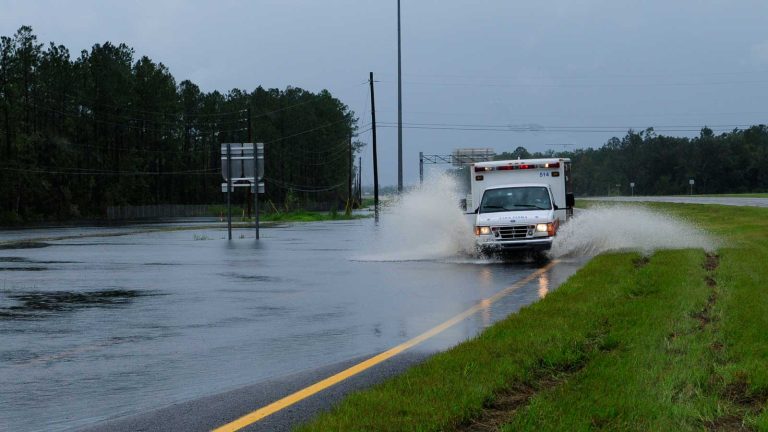It’s August 2023, and time is running out for health care workers along Florida’s Gulf Coast. As Category 4 Hurricane Idalia approaches the coastline, hospital administrators and staff must decide how to prepare themselves, their patients and their facilities.
Four hospitals and eight freestanding emergency rooms in the Tampa Bay metro area were closed in the face of a six-foot storm surge that threatened to engulf streets and potentially flood lower levels of hospitals. The hospital uses ambulances to transport patients to safer places.
Within a month, health care leaders in two other major U.S. cities will face similar tests. On the West Coast, historic rains knocked out power to a Los Angeles hospital, while in New York, heavy downpours caused outages and damage to a Brooklyn hospital — both events prompting emergency evacuations.
Recent hospital closures in the United States illustrate a larger trend that is already underway. According to a report released in December 2023 by the Australian climate risk data company XDI (Cross Dependency Initiative), from 1990 to 2020, human-driven climate change has increased the risk of hospital damage by 41%.
Thousands of health care facilities around the world are overwhelmed by the impacts of climate change, a trend that experts predict will continue in the coming decades as extreme weather increases stress on hospital infrastructure while creating more demand for care. worsen further.
Experts warn
In a May 2024 report, the United Nations Population Fund estimated that nearly 1,500 hospitals are located in low-lying coastal areas of Latin America and the Caribbean that have been hit by life-threatening storms and flooding. More than 80% of hospitals in Aruba, the Bahamas, the Cayman Islands, Guyana and Suriname are located in these risk areas.
A 2022 study by Harvard University researchers showed that hundreds of hospitals in the United States are at risk from flooding. Along the Atlantic and Gulf Coast, hospitals in Delaware, Florida, Louisiana, New Hampshire, Massachusetts, Maryland, New Jersey, New York and Pennsylvania are most vulnerable to 2 Threat of flooding caused by hurricane-force winds.
On the other side of the world, raging floods and landslides caused the closure of 12 medical facilities in five southern Thai provinces in 2023. 10% of the country’s medical institutions.
XDI researchers examined the climate risks faced by some 200,000 hospitals from floods, fires and hurricanes and estimated that one in 12 hospitals globally could be at risk of full or partial closure due to extreme weather by the end of the century.
Some areas are more vulnerable than others. The report estimates that under 4.3 degrees Celsius of global warming, more than 5,800 hospitals in South Asia alone, including India, the world's most populous country, are at high risk of closing.
However, other regions are not immune. More than half of the hospitals in the Central African Republic and more than a quarter of the hospitals in the Philippines and Nepal will face the same fate.
Pressure and heat combine
The summer of 2023 was the hottest on record. Scorching temperatures are bringing deadly heat waves and wildfires that are sweeping through forests and surrounding towns, all of which could impact human health and the hospitals and clinics where people seek treatment.
WMO Secretary-General Petteri Taalas said in a statement: “The Northern Hemisphere has just experienced an extreme summer – with recurring heat waves fueling devastating wildfires, damaging health, disrupting daily life and affecting climate change. Lasting damage was done to the environment.
That summer, for example, in Arizona, extreme heat stressed the power grid and prompted an influx of people requiring medical care for heat stress.
A 2021 study found that in Taiwan, heat-related emergency room visits increased by 50% on days when wet-bulb temperatures (wet-bulb temperatures include both heat and humidity) were at least 89.6 degrees Fahrenheit. At this level, it's harder for sweat to evaporate, so it's harder for people to cool themselves down.
Looking ahead to risks
In the coming decades, health care infrastructure will face increasing stress from the effects of extreme weather and rising temperatures—power outages, hospital closures, and building damage.
At the same time, the need for care is likely to grow. In the next 25 years, climate change is expected to worsen more than half of all known human diseases, expand the scope of fungal infections, and increase the risk of viral and mosquito-borne diseases. At the same time, extreme heat is likely to send more and more people to the hospital.
Making major changes to how a hospital operates may seem daunting, but facilities can start small, adapt, and create unique solutions that fit their needs.
An example of this approach can be found in Vietnam. About half of the country's hospitals do not have a reliable source of water, whether due to drought, flooding or saltwater intrusion. The result: patients often have to bring their own. Faced with this significant barrier to care, three rural hospitals in Vietnam launched projects to increase climate resilience by addressing water supply issues. Each of these agencies has found innovative ways to get more water using solutions such as rainwater harvesting and storage systems, brine filtration, and better infrastructure to capture nearby water flows.
“Unfortunately, we expect climate change to increasingly threaten water supplies for health care facilities across Vietnam, so rapid adaptation measures are critical,” Angela Platt, WHO Representative in Vietnam, said in a press release.
As the impacts of climate change push healthcare systems to higher risk levels, hospital leadership teams around the world must begin developing climate resiliency plans related to infrastructure and people to safeguard healthcare on a changing planet.
Caitlin Sullivan is a freelance journalist. She covers health, science and the environment. This article was written in collaboration with Energy Innovation and the Aspen Institute on Global Change. Both organizations are Yale Climate Connect content sharing partners.
We help millions of people understand climate change and what to do about it. Help us reach more people like you.

